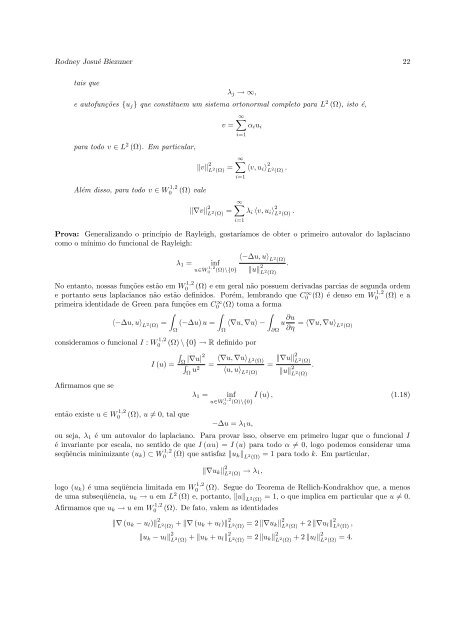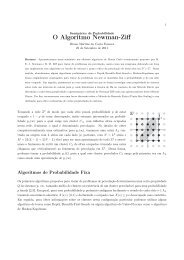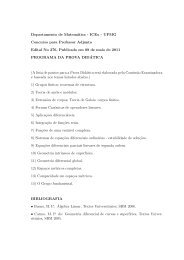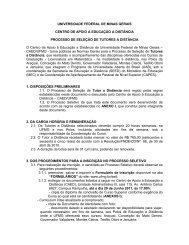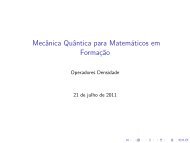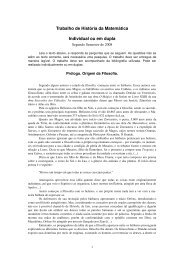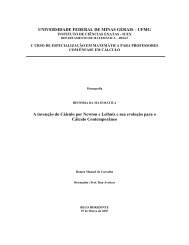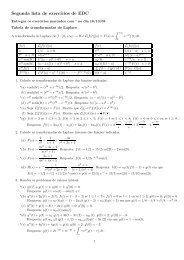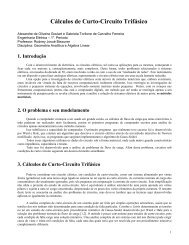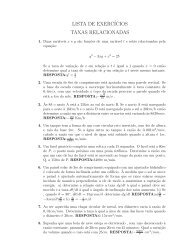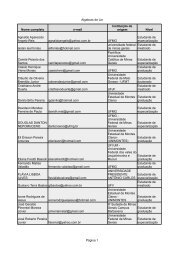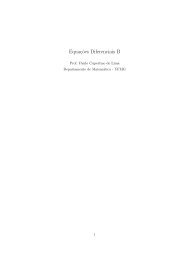Autovalores do Laplaciano - Departamento de Matemática - UFMG
Autovalores do Laplaciano - Departamento de Matemática - UFMG
Autovalores do Laplaciano - Departamento de Matemática - UFMG
You also want an ePaper? Increase the reach of your titles
YUMPU automatically turns print PDFs into web optimized ePapers that Google loves.
Rodney Josué Biezuner 22<br />
tais que<br />
λj → ∞,<br />
e autofunções {uj} que constituem um sistema ortonormal completo para L 2 (Ω), isto é,<br />
para to<strong>do</strong> v ∈ L 2 (Ω). Em particular,<br />
Além disso, para to<strong>do</strong> v ∈ W 1,2<br />
0 (Ω) vale<br />
v =<br />
v 2<br />
L 2 (Ω) =<br />
∇v 2<br />
L 2 (Ω) =<br />
∞<br />
i=1<br />
∞<br />
i=1<br />
∞<br />
i=1<br />
αiui<br />
〈v, ui〉 2<br />
L 2 (Ω) .<br />
λi 〈v, ui〉 2<br />
L 2 (Ω) .<br />
Prova: Generalizan<strong>do</strong> o princípio <strong>de</strong> Rayleigh, gostaríamos <strong>de</strong> obter o primeiro autovalor <strong>do</strong> laplaciano<br />
como o mínimo <strong>do</strong> funcional <strong>de</strong> Rayleigh:<br />
λ1 = inf<br />
u∈W 1,2<br />
0 (Ω)\{0}<br />
〈−∆u, u〉 L2 (Ω)<br />
u 2<br />
L2 .<br />
(Ω)<br />
No entanto, nossas funções estão em W 1,2<br />
0 (Ω) e em geral não possuem <strong>de</strong>rivadas parcias <strong>de</strong> segunda or<strong>de</strong>m<br />
e portanto seus laplacianos não estão <strong>de</strong>fini<strong>do</strong>s. Porém, lembran<strong>do</strong> que C∞ 0 (Ω) é <strong>de</strong>nso em W 1,2<br />
0 (Ω) e a<br />
primeira i<strong>de</strong>ntida<strong>de</strong> <strong>de</strong> Green para funções em C∞ 0 (Ω) toma a forma<br />
<br />
〈−∆u, u〉 L2 (Ω) =<br />
Ω<br />
<br />
(−∆u) u =<br />
Ω<br />
<br />
〈∇u, ∇u〉 −<br />
consi<strong>de</strong>ramos o funcional I : W 1,2<br />
0 (Ω) \ {0} → R <strong>de</strong>fini<strong>do</strong> por<br />
Afirmamos que se<br />
I (u) =<br />
então existe u ∈ W 1,2<br />
0 (Ω), u = 0, tal que<br />
<br />
Ω |∇u|2<br />
<br />
Ω u2 = 〈∇u, ∇u〉 L2 (Ω)<br />
〈u, u〉 L2 (Ω)<br />
∂Ω<br />
u ∂u<br />
∂η = 〈∇u, ∇u〉 L 2 (Ω)<br />
L2 (Ω)<br />
u 2<br />
L2 (Ω)<br />
= ∇u2<br />
λ1 = inf<br />
u∈W 1,2<br />
I (u) , (1.18)<br />
0 (Ω)\{0}<br />
−∆u = λ1u,<br />
ou seja, λ1 é um autovalor <strong>do</strong> laplaciano. Para provar isso, observe em primeiro lugar que o funcional I<br />
é invariante por escala, no senti<strong>do</strong> <strong>de</strong> que I (αu) = I (u) para to<strong>do</strong> α = 0, logo po<strong>de</strong>mos consi<strong>de</strong>rar uma<br />
seqüência minimizante (uk) ⊂ W 1,2<br />
0 (Ω) que satisfaz uk L 2 (Ω) = 1 para to<strong>do</strong> k. Em particular,<br />
∇uk 2<br />
L2 (Ω) → λ1,<br />
logo (uk) é uma seqüência limitada em W 1,2<br />
0 (Ω). Segue <strong>do</strong> Teorema <strong>de</strong> Rellich-Kondrakhov que, a menos<br />
<strong>de</strong> uma subseqüência, uk → u em L 2 (Ω) e, portanto, u L 2 (Ω) = 1, o que implica em particular que u = 0.<br />
Afirmamos que uk → u em W 1,2<br />
0 (Ω). De fato, valem as i<strong>de</strong>ntida<strong>de</strong>s<br />
∇ (uk − ul) 2<br />
L2 (Ω) + ∇ (uk + ul) 2<br />
L2 2<br />
(Ω) = 2 ∇ukL2 2<br />
(Ω) + 2 ∇ulL2 (Ω) ,<br />
uk − ul 2<br />
L2 (Ω) + uk + ul 2<br />
L2 2<br />
(Ω) = 2 ukL2 2<br />
(Ω) + 2 ulL2 (Ω) = 4.<br />
.


